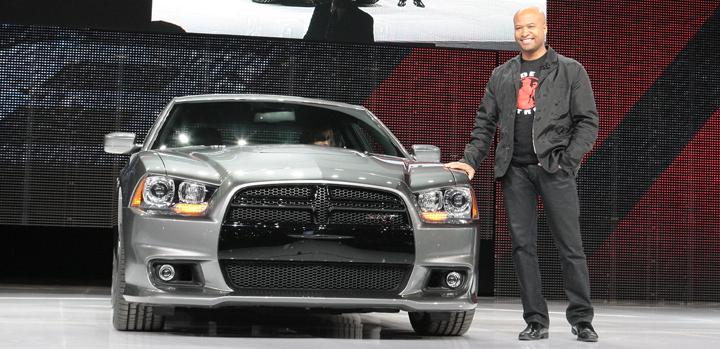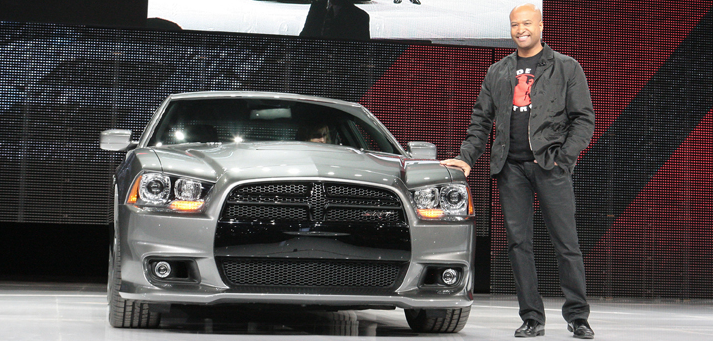
From an early age, Ralph Gilles, Senior Vice President of Product Design at Chrysler, dreamed of becoming a car designer. “I’ve always loved cars,” he said. “I played with them. I didn’t have video games, we didn’t have iPhones, we didn’t have Macs. That was my thing. I would make model cars.”
Dodge Goes Wide: Meet the 2018 Challenger SRT Hellcat Widebody
Recently, Gilles recounted his life story at a Chrysler recruiting event at Northwestern University. During his speech to an assembly of students, he talked about his rise to the head of the SRT Brand and Motorsports department and to his post as Senior VP.
“I had big dreams,” he said. “I literally wrote a letter to Chrysler: I wanted to make cars. They were kind enough to say, ‘This is what you’ve got to do. There are four [car-design] schools in the U.S.’ The College for Creative Studies in Detroit was the closest one.”
Gilles’ father was instrumental in motivating him to achieve his dream. He taught him to admire people that affect change. Gilles said: “My aspirational targets were not my neighbor or minister. It was Martin Luther King. He was trying to say, ‘This guy paved the way for you; don’t mess it up.’ I think he paved the way for a lot of people, not just the black community. And Nelson Mandela [is] one of my heroes. Will Smith [said this] upon meeting Nelson Mandela: ‘A man like Nelson makes you realize how small you are. At the same time he makes you realize how big you can be.’ That was the whole motto that my dad was trying to get into my thick skull, was this is how big you can be. He didn’t mean big in money or compensation or titles. He meant big in doing something. Affecting change, touching a lot of lives. Those are words I live by.”
When he started his collegiate career, Gilles studied engineering but felt very intimidated by the schooling, so he dropped out and lived in his parents’ basement for a year. He told his parents he wanted to follow his childhood dream of becoming a car designer. At first they resisted, but eventually his father talked with him: “‘To [become a car designer], there’s no shortcut.’ It was a very important speech he had with me. ‘You’ve got to get the education and you’ve got to take it seriously.’” Gilles enrolled at the College for Creative Studies in Detroit, where he earned a degree in industrial design.
Future Collectibles: 2017 Dodge Viper
Gilles joined Chrysler in 1992 as a car designer. He cites the Dodge Viper as a catalyst in the decision: “The Viper is a symbolic car for me because it’s one of the reasons I went to Chrysler. . . . When I saw that car as a show car as a student, I wasn’t taking Chrysler seriously. They had K-cars. But then I saw the Viper as a concept car and thought, ‘Oh, my God. Any car company that has the gall to do something like this, I want to be a part of.’”
His role in the company changed over time. Gilles earned a master’s degree in business administration from Michigan State and was promoted into management, where he held several positions. Regarding his ascension in the company ranks, “I just wanted to draw cars when I was a kid. Period. And today I virtually never do that anymore,” he said. “I lead people, I speak to people, I do strategy, I do plans, I manage billions of dollars. I never went to school for that. So I had to dig deep into myself to manage those challenges, and the only way to do that is to connect with other people that can do that stuff. So the relationships [are] what it’s all about. This company was saved by relationships, and if it’s anything you learn, it’s that. Don’t ever forget that. ”
He also pointed to the challenge of redesigning 18 vehicles in the space of two years in preparation for the model-year 2010 timeframe. He managed the team responsible for tackling such a feat, and he described the motivation, hard work, and long hours as a “military feeling. . . . It was such an intoxicating feeling to work like that, at that level, for so long.” The hard work resulted in vehicles that are attracting praise from the media and resulting in higher sales with fewer buying incentives. “What’s happened in the marketplace is that we’re actually running out of cars,” he said. “We have dealers that are selling everything. They used to stock two or three new models, and the rest they would ignore. Now they want everything. We have 27 nameplates, and they want all of them. It’s a fun feeling.”
Put in charge of the SRT performance-oriented brand, Gilles was responsible for managing the development of the fifth-generation Viper, the company’s iconic supercar. Gilles said it was an honor and privilege to be part of the development of the fifth-generation Viper, since the Viper concept car inspired him to join Chrysler. He also talked a little about that car’s legacy: “[The original car is] the most magazine-covered car in history. The new car has already gotten many covers. . . . We’re seeing some fantastic headlines. And this stuff [media coverage] is priceless. You can’t put a value on it. The car will make a few million bucks, but it’s really about this. It’s about building a brand and having [the Viper] pull up the other cars.”
He also had this to say about his personal mission at Chrysler: “Cars from Detroit used to be a dumb thing. If you bought an American car, you were obviously ill-informed. Today, I want to change that conversation. I want buying a car from an American company to be something to be proud of. Even if you look down the street, you see it and think, ‘Whoa, that’s an American car? Damn, that’s good-looking.’ That’s the way it used to be. So I want [the attitude to be], ‘Don’t buy a car just because it’s American, buy it because it’s good.’”



